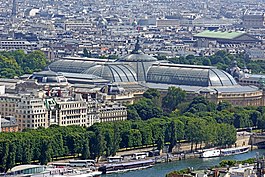You can help expand this article with text translated from the corresponding articles in French and Spanish. (July 2024) Click [show] for important translation instructions.
|
 | |
 | |
| Established | Universal Exposition of 1900 |
|---|---|
| Location | Avenue Winston-Churchill, 75008 Paris, France |
| Coordinates | 48°51′58″N 2°18′45″E / 48.86611°N 2.31250°E |
| Type | Historic site, exhibition hall |
| Visitors | 1,412,060 (2017)[1] |
| President | Jean-Paul Cluzel |
| Public transit access | Champs-Élysées–Clemenceau Franklin D. Roosevelt |
| Website | http://www.grandpalais.fr/ |
The Grand Palais des Champs-Élysées (French pronunciation: [ɡʁɑ̃ palɛ de ʃɑ̃z‿elize]; English: Great Palace of the Champs-Élysées), commonly known as the Grand Palais, is a historic site, exhibition hall and museum complex located in the 8th arrondissement of Paris between the Champs-Élysées and the Seine, France. Construction of the Grand Palais began in 1897 following the demolition of the Palais de l'Industrie (Palace of Industry) to prepare for the Universal Exposition of 1900.[2] That exposition also produced the adjacent Petit Palais and Pont Alexandre III.[3]
The building was designed to be a large-scale venue for official artistic events. A pediment on the building refers to this function with an inscription that reads, "a monument dedicated by the Republic to the glory of French art." Designed according to Beaux-Arts tastes, the building features ornate stone facades, glass vaults and period innovations that included iron and light steel framing and reinforced concrete.[4]
It is listed as a historic monument (monument historique) by the Ministry of Culture.[5]
- ^ The Art Newspaper Review, April 2018
- ^ "L'Exposition Universelle de 1900".
- ^ "Grand Palais". Champs-elysees-paris.org. Archived from the original on 5 July 2018. Retrieved 8 July 2010.
- ^ Sesan Iwarere (2005). "Paris 1900: Grand Palais". University of Maryland Libraries. Retrieved 23 May 2022.
- ^ Base Mérimée: PA00088877, Ministère français de la Culture. (in French) Grand Palais